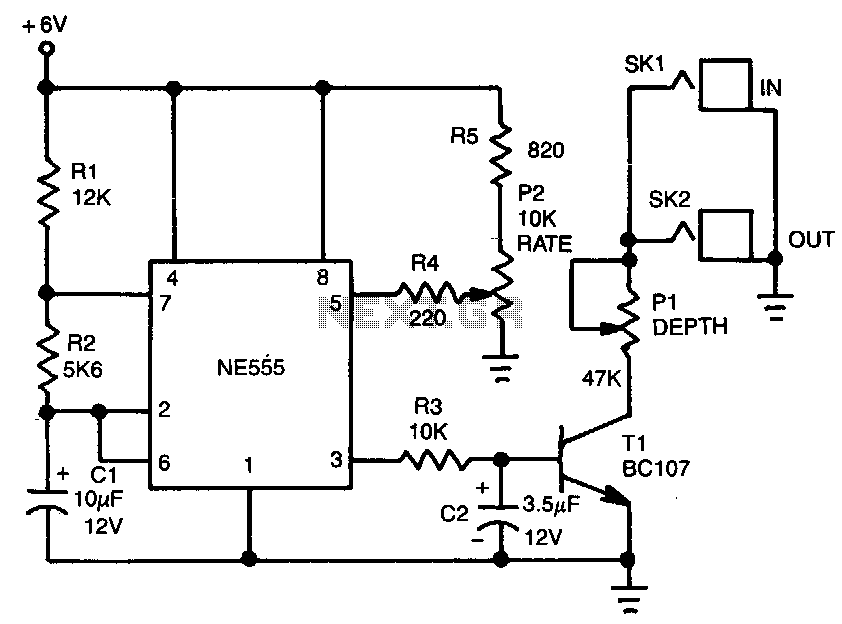
Electronic-tremolo

The tremolo effect is created by a repeating change in volume at a frequency typically ranging from 1 to 15 Hz. A timer generates a low-frequency square wave, which is subsequently smoothed by a simple RC integrator. This varying signal modulates the input signal from the instrument. Transistor T1 functions as a voltage-controlled resistor. The output of the circuit is connected in parallel with the instrument's output. Additionally, potentiometer P1 allows for depth control by adjusting the amplitude of the modulating waveform applied to the instrument, while potentiometer P2 sets the frequency of the rate control.
The tremolo effect circuit utilizes a timer, commonly configured as an astable multivibrator, to produce a square wave output. This square wave oscillates between high and low states, which corresponds to the volume modulation. The frequency of this oscillation is adjustable via potentiometer P2, allowing users to select the desired tremolo speed within the specified range of 1 to 15 Hz.
The output from the timer feeds into an RC integrator, which serves to smooth the sharp transitions of the square wave, converting it into a more gradual wave shape. This smoothed waveform is then used to modulate the input signal from the instrument. By employing a transistor, specifically T1, as a voltage-controlled resistor, the circuit effectively controls the amplitude of the audio signal based on the modulating waveform. This configuration allows for dynamic volume changes that create the characteristic tremolo effect.
Potentiometer P1 plays a crucial role in determining the depth of the tremolo effect. By adjusting P1, the user can change the amplitude of the modulating waveform, thus affecting how pronounced the volume fluctuations are during operation. A higher setting on P1 results in a more pronounced tremolo effect, while a lower setting yields subtler modulation.
In summary, the tremolo circuit comprises a timer generating a low-frequency square wave, an RC integrator for waveform smoothing, a voltage-controlled resistor implemented with a transistor, and two potentiometers for controlling the depth and rate of the effect. This setup allows for versatile modulation of the audio signal, enhancing the overall sound texture of the instrument.The tremolo effect is generated by a repeating volume change at a rate usually between 1 and 15Hz. The timer produces a low frequency square wave that is smoothed by a simple rc integrator. This varying signal modulates the signal input from the instrument. Transistor Tl is used as a voltage controlled resistor. The output of the circuit is connected in parallel to the output of the instrument. Potentiometer P1 provides depth control by adjusting the amplitude of the modulating waveform applied to the instrument. The rate contrul frequency is set by potentiometer P2. 🔗 External reference
The tremolo effect circuit utilizes a timer, commonly configured as an astable multivibrator, to produce a square wave output. This square wave oscillates between high and low states, which corresponds to the volume modulation. The frequency of this oscillation is adjustable via potentiometer P2, allowing users to select the desired tremolo speed within the specified range of 1 to 15 Hz.
The output from the timer feeds into an RC integrator, which serves to smooth the sharp transitions of the square wave, converting it into a more gradual wave shape. This smoothed waveform is then used to modulate the input signal from the instrument. By employing a transistor, specifically T1, as a voltage-controlled resistor, the circuit effectively controls the amplitude of the audio signal based on the modulating waveform. This configuration allows for dynamic volume changes that create the characteristic tremolo effect.
Potentiometer P1 plays a crucial role in determining the depth of the tremolo effect. By adjusting P1, the user can change the amplitude of the modulating waveform, thus affecting how pronounced the volume fluctuations are during operation. A higher setting on P1 results in a more pronounced tremolo effect, while a lower setting yields subtler modulation.
In summary, the tremolo circuit comprises a timer generating a low-frequency square wave, an RC integrator for waveform smoothing, a voltage-controlled resistor implemented with a transistor, and two potentiometers for controlling the depth and rate of the effect. This setup allows for versatile modulation of the audio signal, enhancing the overall sound texture of the instrument.The tremolo effect is generated by a repeating volume change at a rate usually between 1 and 15Hz. The timer produces a low frequency square wave that is smoothed by a simple rc integrator. This varying signal modulates the signal input from the instrument. Transistor Tl is used as a voltage controlled resistor. The output of the circuit is connected in parallel to the output of the instrument. Potentiometer P1 provides depth control by adjusting the amplitude of the modulating waveform applied to the instrument. The rate contrul frequency is set by potentiometer P2. 🔗 External reference